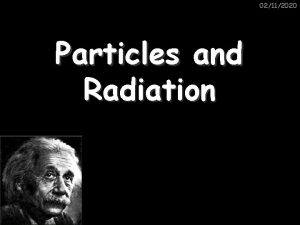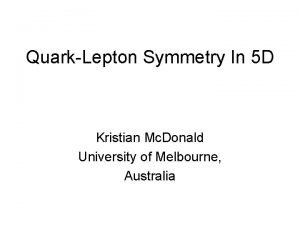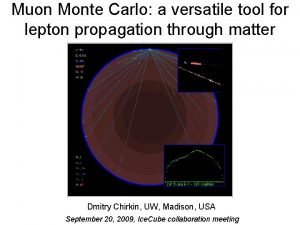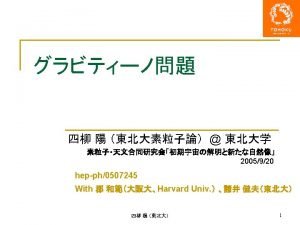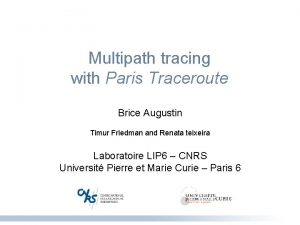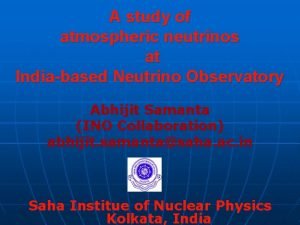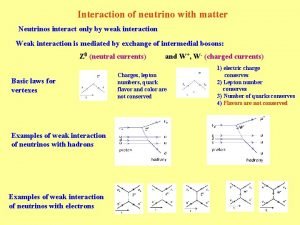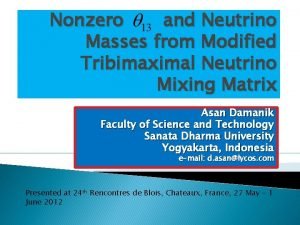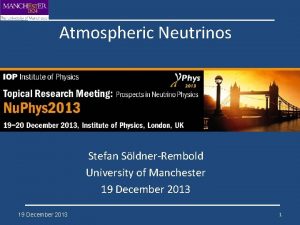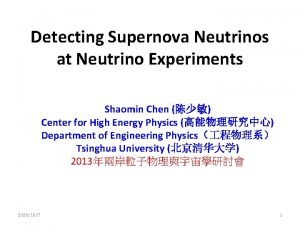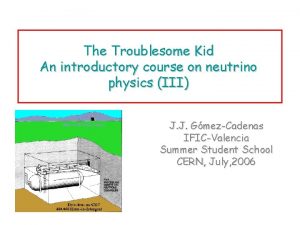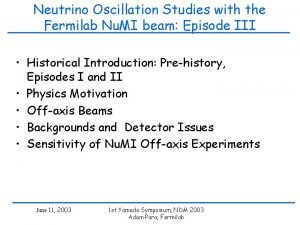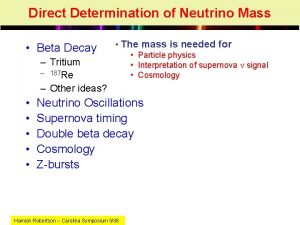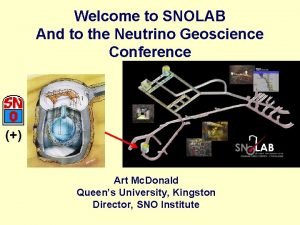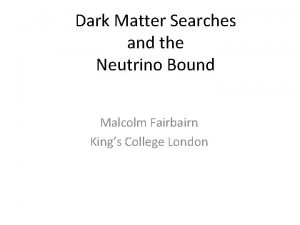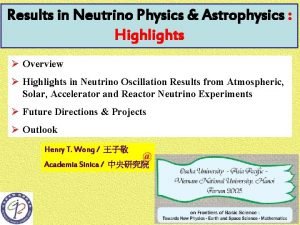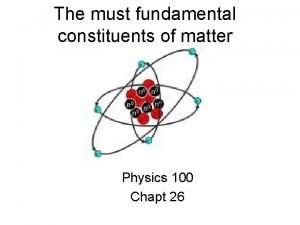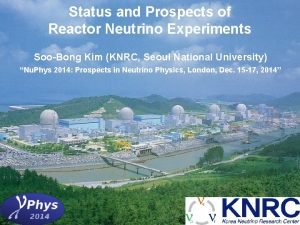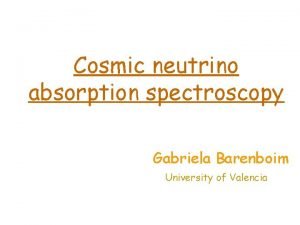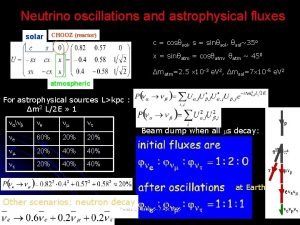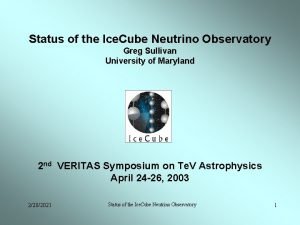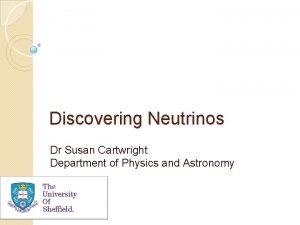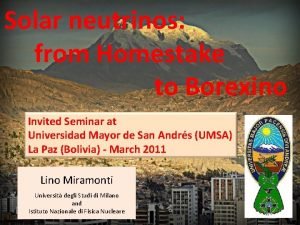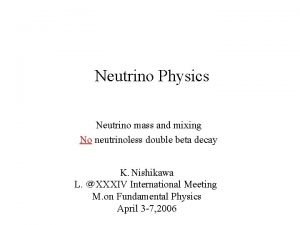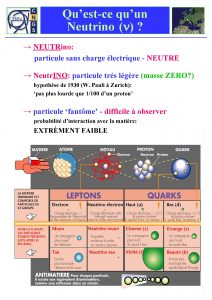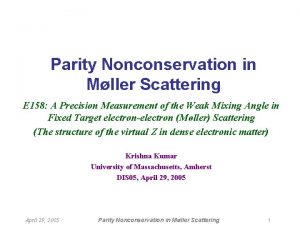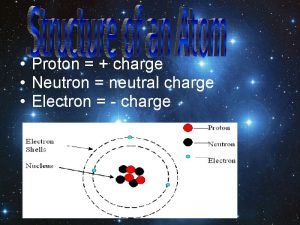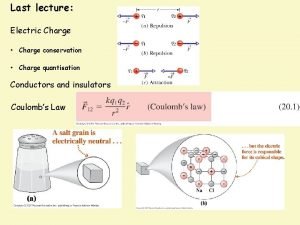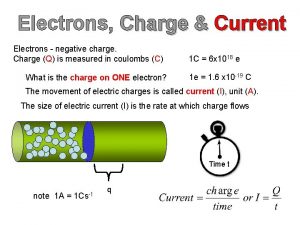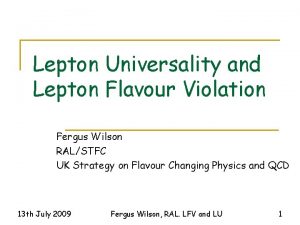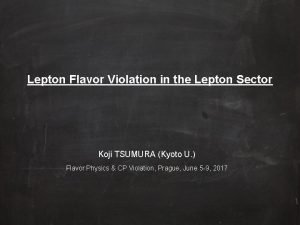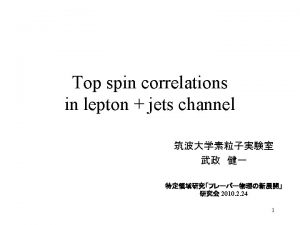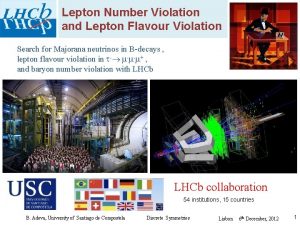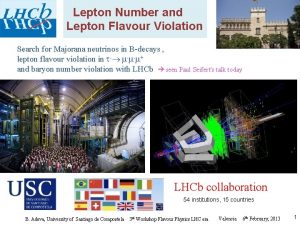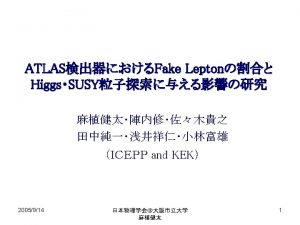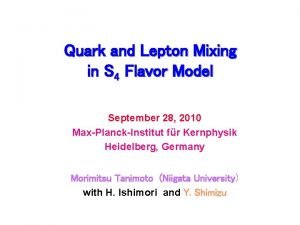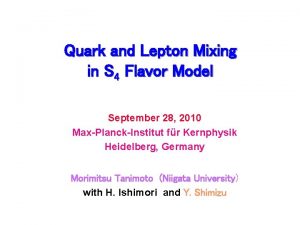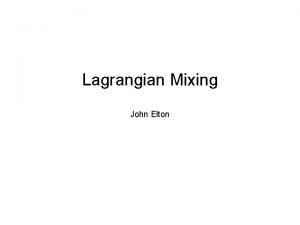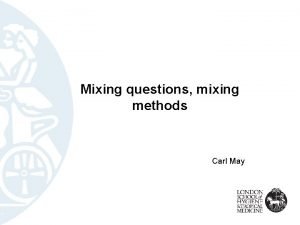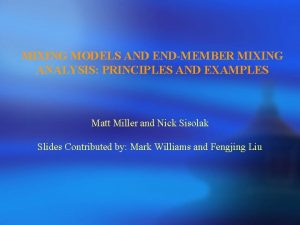Lepton mixing under the lepton charge nonconservation neutrino






























- Slides: 30

Lepton mixing under the lepton charge nonconservation, neutrino masses and oscillations and the “forbidden” decay - e - + Valery V. Lyuboshitz, V. L. Lyuboshitz ( JINR, Dubna, Russia ) 09. 2013 PHI PSI 13 Workshop, Rome, Italy, September 9 - 12, 2013 1

1. Lepton charge nonconservation and mixing of leptons with different flavors • The lepton charge nonconservation ( nonconservation of the lepton numbers ) leads to the mixing of the electron, muon and tau neutrinos, which manifests itself in the spatial oscillations at the neutrino beam propagation in vacuum [B. Kayser, Phys. Lett. B 667, 163 (2008)]. At the same time, the lepton-charge non-conserving interaction should also weakly mix the ordinary leptons with the same electric charge ( e–, – , as well as e+, + ) and should be, in particular, the cause of the nonzero probabilities of the – decay into the electron and quantum and the + decay into the positron and quantum, which are forbidden under the lepton charge conservation.

• Let us emphasize that, in the framework of the scheme under consideration, the total lepton number is conserved. • It is accepted to take the lepton numbers of the electron and electron neutrino to be equal to , those of the negative muon and muon neutrino – to , and those of the – lepton and tau neutrino – to. For antiparticles, the respective lepton numbers have the opposite sign : for the positron and electron antineutrino, and for the positive muon and muon antineutrino, for the + lepton and tau antineutrino.

2. Mass matrix and neutrino states with the definite masses • Taking into account the CP invariance ( T invariance ), the mass matrix for the neutrino family should be symmetric and, due to hermiticity, real. It has the general structure of the form : (1) • The diagonal elements of this mass matrix have the meaning of the masses of electron neutrino ( ) , muon neutrino ( ) and tau neutrino ( ) , whereas the nondiagonal elements ( ) characterize the degree of lepton charge nonconservation. {Due to the CPT invariance, the mass matrices for neutrinos and antineutrinos should coincide ( )} .

• In doing so, the states with the definite lepton charge ( “flavor” ) are connected with the stationary states , being related with the definite masses m 1 , m 2 , m 3, by the following unitary transformation : (2) • Let us note that, due to T invariance , the unitary matrix is real. This means that the inverse matrix coincides with the transposed primary one ( ). Thus, the states with the definite lepton charge represent the coherent superpositions of stationary states, and the stationary states represent the superpositions of states with the definite lepton charge, having the same coefficients : (3) (4)

• The elements of the unitary matrix in Eqs. (3) and (4) are scalar products of the neutrino states with the definite lepton charge and neutrino stationary states : (5) It is obvious that the neutrino stationary states – as the eigenstates of the mass matrix, corresponding to the different masses m 1 , m 2 and m 3 – are mutually orthogonal : (6) in accordance with the unitarity condition, due to which the following equality holds: (7)

3. Neutrino oscillations • Just the difference of masses of neutrino stationary states is the cause of neutrino oscillations. • If a neutrino is generated, at a fixed energy E, in the state with the definite lepton charge ( “flavor” ) ( – electron, muon or tau neutrino), then, at the finite distance L from the point of generation, it turns into the superposition of the form ( see Eqs. (3), (4) ) : , (8) where pi is the momentum of the stationary neutrino with the mass mi at the energy E. Since neutrinos are in fact ultrarelativistic particles, we may write: . (9) ( In relations (8) and (9) , c is the velocity of light in vacuum and the Planck constant ). is

Then the amplitude of transition of the electron neutrino into the muon one at the distance L from the generation point will have the form : (10) Taking into account the unitarity condition, which implies the equality : , (11) the probability of transition of the electron neutrino into the muon one at the distance L from the generation point is as follows : (12)

• In doing so, the arguments of oscillating terms in Eq. (12) may be presented in the form : , where the masses are given in , the energy – in Ge. V, and the distance L – in kilometers. The respective periods of spatial oscillations are equal to. Let us remark that if at a given distance L the condition is satisfied and, meanwhile, we have , then formula (12) is simplified : (13) since, owing to the unitarity condition for the matrix. , (14)

• In doing so, . (15) Formula (15) describes, in particular, the decrease of intensity of the beam of reactor antineutrino with energy around several Me. V at comparatively small distances from the reactor on account of the transition of the electron antineutrino into the muon one, which is “sterile” below the threshold of meson production. Analogously, the probability of transition of the electron neutrino into the tau neutrino at the distance L from the point of generation is described by Eq. (12) with the replacements: .

• Meantime, the probability of the event that the electron neutrino does not change its “flavor” at the distance L from the point of generation amounts to : (16) Here, we have taken into account that, in accordance with the unitarity condition, .

• Just as one should expect, the unitarity relation ensures the equality. • According to the relations (11), (12) and (16), the admixtures of muon and tau neutrinos, averaged over the spatial oscillations ( over the energy spectrum at a given distance L ) , are, respectively, as follows : , (17) , (18) and the average intensity of the beam of electron neutrinos, attenuated as a result of spatial oscillations, is proportional to : . (19) It can be shown that the absolute minimum of the quantity is equal to ⅓ – in accordance with the number of stationary neutrinos n=3.

4. Nondiagonal elements of the mass matrix and their connection with the differences of neutrino masses • By applying relations (3), the nondiagonal elements of the mass matrix can be expressed through the differences of masses of neutrino stationary states and the elements of the unitary matrix. Indeed, it is easy to see that : (20) , as before. where mi is the neutrino mass in the stationary state Taking into account the unitarity condition: , we obtain the following expressions for the mass matrix element : , (21) or. (22) Analogous expressions may be obviously written for the mass matrix elements and.

• In terms of the mixing angles for the neutrino stationary states, which are formally analogous to the Maiani angles introduced for the description of mixing of “lower” quarks d, s and b [Kayser, 2008; Goodman, 2008; Okun, 1990; Maiani, 1976], the matrix can be presented in the form : (23) According to (23), we have : (24) As a result, Eq. (21) gives : (25) Formula (25), determining the matrix element , incorporates the values of differences of stationary neutrino masses. Meantime, the experimental data on neutrino oscillations contain the information only on the differences of squares of masses.

• If the moduli of differences of mass squares are very small as compared with the square of each of the masses ( which seems to be plausible ), then the masses of all the three stationary neutrinos may be assumed to be approximately equal to each other: . (26) In this situation, the moduli of all the differences of masses are very small as compared with the common neutrino mass : . (27) • Within this approximation, the differences of stationary neutrino masses are determined according to the formulas { The experimental data on oscillations [Kayser, 2008] testify to the fact that. This means that the difference of masses of the first and second stationary neutrinos is very small as сompared with their distinction from the third stationary neutrino, which is itself also relatively small } : (28) Taking into account relations (28), we may rewrite Eq. (25) in the form : (29)

5. States of charged leptons with the definite masses • Taking into account the lepton-charge non-conserving interaction, the mass matrix for the family of leptons, including the electron, the negative muon and the – lepton, has the form being analogous to the mass matrix for the neutrino family : . (30) The diagonal elements of the mass matrix are equal to the masses of electron ( , ), negative muon ( , ) and – lepton ( , ), whereas the nondiagonal elements, being responsible for the lepton charge nonconservation, are negligibly small as compared with the electron mass Me and, all the more, as compared with all the differences of masses. Just the same mass matrix corresponds to the family of antileptons, incorporating the positron ( ), the positive muon ( ), and the + lepton ( ).

• Due to T invariance, the Hermitian matrix real : should be symmetric and, hence, (31) • Within the perturbation theory first-order approximation, the stationary states of leptons represent the superpositions of states with different lepton charges : , , (32) . • The stationary states, denoted by prime, are related with different masses. In doing so, these masses practically coincide with the masses of leptons : (33) and the coefficients of mixing of states with different lepton charges are expressed through the ratios of nondiagonal elements of the mass matrix to the differences of masses of respective leptons.

Indeed, neglecting the second-order terms over the lepton-charge nonconserving interaction, we find : ; ; (34) . Let us note that, taking into account the small values of mixing coefficients, relations (34) follow also from the expressions being analogous to Eqs. (21) and (22) for neutrinos. In Eqs. (32), the symbols and denote the “muonic” ( L = 1 ) and “tau-leptonic” ( L = 1 ) states included into the stationary superposition with the electron mass Me , the symbols and denote the “electronic” ( Le = 1) and “tau-leptonic” ( L = 1 ) states included into the stationary superposition with the muon mass M , and the symbols and denote the “electronic” ( Le = 1 ) and “muonic” ( L = 1 ) states included into the stationary superposition with the -lepton mass M .

6. Coefficient of mixing of the states with the lepton charges Le = 1 and L = 1 and probability of the decay – e– + • Let us estimate the probability of the radiative decay – e– + , being forbidden under the lepton charge conservation, assuming that this decay occurs on account of “admixture” of the state with the electronic lepton number Le = 1 and the muon mass to the negative muon. Then the probability of decay – e– + per unit time will be as follows : , • where Eqs. (32). (35) is the mixing coefficient included in the second formula in

• Meantime, the differential probability of decay of the “heavy electron” with mass M into the ordinary electron with momentum (36) ( is the unit vector along the momentum ) and the quantum with energy (37) per unit time can be calculated according to the standard formula of quantum electrodynamics [Berestetsky, Lifshitz, Pitaevsky, 1983] : , (38) where is the fine structure constant, is the frequency of quantum, is the vector of polarization of quantum, is the Dirac bispinor describing the ordinary electron with mass Me and momentum p , is the four-row Dirac matrix ( [Berestetsky, Lifshitz, Pitaevsky, 1983] ) , 0 is the Dirac bispinor corresponding to the resting “heavy electron” with mass M , .

• Passing to the two-row Pauli matrices , we may write : , where u 0 (39) and v 0 are the two-row spinors, normalized by unity, and. • (40) In doing so, we have : . (41) Taking into account that the final electron is ultrarelativistic , we obtain the following expression – after averaging the differential probability of emission over the polarizations of the “heavy electron” and summing over the polarizations of the quantum and final ordinary electron : (42)

• The total probability of radiative decay of the “heavy electron” per unit time amounts to : . (43) Taking into account the numerical values ( ), the probability of radiative decay of the electronic state with mass M (per 1 sec. ) equals. (44) According to relations (35) and (38) , (45)

• As follows from the experimental data [ Review of Particle Physics, B 667, 2008, p. 34, 36 ] , , (46) where is the probability of decay of the negative muon into the electron, electron antineutrino and muon neutrino per unit time, coinciding practically with the inverse lifetime of the muon : . Thus, in accordance with the experimental restriction (46), we obtain : . (47) Taking into account Eqs. (35), (43) and (45), this means that: (48)

7. Hypothesis on the equality of nondiagonal elements of the mass matrices for neutrinos and charged leptons and the estimate of the lower bound of neutrino mass • Let us suppose that the mixing of ordinary leptons ( e , , ) and the mixing of neutrinos ( ) are conditioned by the same leptoncharge non-conserving interaction. Under this natural assumption, the non-diagonal elements of the three-row mass matrix for the lepton family should coincide with those of the three-row mass matrix for neutrinos : . Thus, we will assume that the matrix element (45). may be replaced by the matrix element neutrino family. (49) , included into formula corresponding to the

• Then, taking into account Eq. (29) and inequalities (48), we obtain the relation for estimating the lower bound of the neutrino mass : (50) • According to the experimental data on neutrino oscillations [ Review of Particle Physics, B 667, 2008, p. 34, 36 ] , ; .

• Assuming, respectively, that we find : . • (51) This value for the lower bound of neutrino mass is in good agreement with the upper limit of antineutrino mass determined in the works by Lobashev et al. [ Phys. Lett. B 460, 227, 1999 ] ( ) and Kraus et al. [ Eur. Phys. J. , C 40, 447, 2005 ] ( ) within the study of electron spectrum in the tritium -decay ( see also [ Review of Particle Physics, B 667, 2008, p. 34, 36 ] ).

8. Concluding remarks • Let us emphasize that our estimate for the lower bound of neutrino mass is based on the experimental data on neutrino oscillations, on the experimental restriction for the probability of decay – e– + per unit time and on the assumption that the nondiagonal element of the neutrino mass matrix , characterizing the mixing of muon and electron neutrino on account of the lepton charge nonconservation, coincides with the nondiagonal element of the mass matrix for ordinary leptons , characterizing the mixing of negative muon and electron – which seems natural from our point of view. • Meantime, if , then the value for the lower bound of neutrino mass will change as compared with the magnitude obtained above. In this case, , where is the ratio of nondiagonal elements of the mass matrices for leptons and neutrinos.

• If, in further experiments, the probability of decay – e – + per 1 sec will be determined or the upper limit of this probability will be reduced, this will testify to the fact that the parameter | | < 1 – since, otherwise, we would get a contradiction with the experimental data on the upper bound of neutrino mass. • Under the choice of another set of parameters ( taking into account the latest data on nonzero neutrino mixing angle θ 13 ) : we would obtain the estimate , which may be in accordance with the presently known upper limits for the probability of decay – e– + per 1 sec and neutrino mass only at the ratios of moduli of matrix elements.

References • B. Kayser, Phys. Lett. B 667, 163 (2008). • H. Goodman, Phys. Lett. B 667, 546 (2008). • L. B. Okun, Leptony i kwarki ( Leptons and Quarks ), Nauka, Moscow, 1990, ch. 15. • L. Maiani, Phys. Lett. B 62, 183 (1976). • V. B. Berestetsky, E. M. Lifshitz, L. P. Pitaevsky. Kvantovaya electrodinamika ( Quantum Electrodynamics ), Nauka, Moscow, 1983, §§ 43– 45. • Review of Particle Physics, vol. B 667 , p. 34, p. 36. • V. M. Lobashev et al. , Phys. Lett. B 460, 227 (1999). • Ch. Kraus et al. , Eur. Phys. J. C 40 , 447 (2005).

 Neutrino lepton number
Neutrino lepton number Neutrino lepton number
Neutrino lepton number Quark lepton symmetry
Quark lepton symmetry Lepton tool
Lepton tool Lepton-photon
Lepton-photon Seth neddermeyer
Seth neddermeyer Neutrino load balancer
Neutrino load balancer Neutrino
Neutrino Neutrino interaction with matter
Neutrino interaction with matter Neutrino
Neutrino Neutrino
Neutrino Neutrino
Neutrino Nakamura
Nakamura Neutrino
Neutrino Neutrino
Neutrino Neutrino mass
Neutrino mass Solar neutrino
Solar neutrino Neutrino
Neutrino Neutrino mass
Neutrino mass Neutrino symbol
Neutrino symbol Lekka cząstka elementarna mion elektron lub neutrino
Lekka cząstka elementarna mion elektron lub neutrino Neutrino
Neutrino Gabriela barenboim
Gabriela barenboim Neutrino
Neutrino Neutrino beteckning
Neutrino beteckning Neutrino
Neutrino Who discovered neutrino
Who discovered neutrino Solar neutrino
Solar neutrino Difference between charge and electric charge
Difference between charge and electric charge Electrons flowing
Electrons flowing Total flow calculation magic box
Total flow calculation magic box

